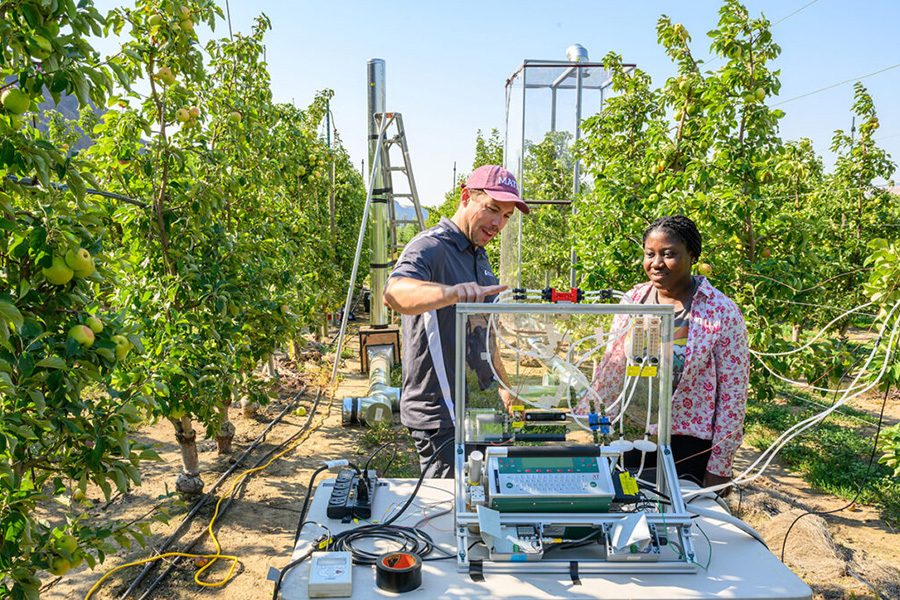
Home » Cold temperatures shrink this year’s pear crop
Cold temperatures shrink this year’s pear crop
Smallest pear harvest in 40 years

WSU Professor Lee Kalcsits, left, and graduate student Harriet Ampofo work on a project to help mitigate impacts on pears and apples from extreme climate events at WSU’s Sunrise Orchard near Wenatchee.
Courtesy WSU Photo ServicesOctober 14, 2024
While Washington is often touted as the apple state, it is also the No. 1 producer of pears in the country – but this year, the Northwest will see the smallest crop of pears in 40 years.
Harvest typically runs from the beginning of August through September, and this year’s crop is estimated to come in at 10.6 million boxes in Washington and Oregon combined. That’s a 31% percent decrease from the Northwest region’s five-year average.
The reason for such a small harvest? A big freeze hit earlier this year.
Pear buds begin developing over the winter, said Jon DeVaney, president of the Washington State Tree Fruit Association, so the cold snap in January damaged them.
That reduced the total number of pears in the crop. Later, cold temperatures caused bloom damage as well, he said.
While other crops, such as cherries, also were affected, it wasn’t to the same extent as the pears. Cherries were in a different phase of development when the temperatures dropped, so mostly higher-elevation fruits were affected.
Pears saw more damage, with the Wenatchee area hit particularly hard. The crop reduction in that region was close to 50%.
Specific varieties are estimated to see different declines as well, with Bosc pear production expected to be down 62% from last year. Green Anjou and Green Bartlett will likely fare better at 26% and 18%, respectively.
Different varieties have different levels of cold tolerance, DeVaney said, and certain locations also are more or less vulnerable. Some of the most popular varieties are Bartlett and Anjou pears, “but Bosc certainly is right up there as well as a very popular variety,” he said.

The Northwest’s pear crop is smaller after a freeze earlier this year damaged pear buds. Washington is the country’s top producer of the fruit.
Cosmetic defects
Not only will the total number of pears be lower, but some of the pears that make it to harvest suffer from another cold weather problem: russeting.
“It’s a cosmetic defect,” DeVaney said. “The fruit itself is still perfectly edible, but it’s a visual blemish that results in it being graded far lower and it’s less desirable by consumers.”
Even though the fruit’s quality is not affected, retailers might not buy pears with russeting or may buy them at a lower price. That means that for some growers, it may not be economic to harvest those pears.
Growers whose pears were damaged can file a crop insurance claim because the damage was weather-related, DeVaney said.
A smaller crop also “means that pears will be getting less shelf space and attention with the lower supply than we’re used to getting,” he said. “And there won’t be as many pears available on the market as consumers might be used to.”
It’s hard to say if that means higher prices for consumers, though, since there are more factors at play than supply and demand, DeVaney said.
Importance of pears
Despite a small pear harvest this year, there are some bright spots in the industry.
DeVaney emphasized the importance pears have in the Pacific Northwest, despite sometimes being seen as a “minor” crop.
Together, Washington and Oregon’s pear industry has an economic impact of over $1.6 billion, DeVaney said, and supports almost 13,000 total jobs in the industry. Washington alone boasted about 18,000 acres of pears in 2022.
WSU research
Cold hardiness patterns for new apple and pear cultivars will be one focus of new research led by Washington State University scientists.
Led by Lee Kalcsits, associate professor and endowed chair of Environmental Physiology for Tree Fruit, the 21-scientist team will research the impact of extreme temperatures on pears, apples and other fruits in the pome family.
“When you look at the statistics, extreme temperatures are the leading cause of reductions in yield and packout,” Kalcsits said in a news release. “Even with our current strategies, losses occur. We need to develop a better understanding of the biological factors leading to those losses, and growers also need more effective options.”
The goal of the research is to make more apples and pears available for consumers.
Latest News Local News Agriculture
KEYWORDS October 2024
Related Articles
Related Products





